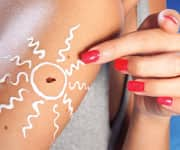Life Extension Magazine®
Skin cancer accounts for 40% of all human malignancies.1
Over 90% of non-melanoma skin cancers are caused by ultraviolet (UV) radiation exposure.2
UV causes skin cancer by damaging cell DNA, inhibiting DNA repair, and impeding the removal of aged cells that cannot be repaired.3-5
Scientists have identified a plant extract that—taken orally prior to sun exposure—inhibits UV-triggered DNA damage.6,7
This natural fern extract also promotes DNA repair,6 and human research has validated its skin-protective capacity.7
PREFACE

This article describes how to markedly reduce solar-induced (UV) skin damage. It pertains to anyone who encounters daily sun exposure.
The first section reveals how UV light damages cellular structures and why such injury accelerates skin aging.
Some readers may find the beginning of this article technically challenging. This information, however, provides a basis to shield one’s skin from within against solar radiation.
How UV Rays Damage DNA

Sun exposure promotes formation of cancer-producing compounds that trigger DNA mutations.8-10
Ultraviolet (UV) solar radiation stimulates formation of DNA photoproducts—such as cyclobutane pyrimidine dimers—that are highly mutagenic and DNA-altering.11
UV-generated photoproducts alter a vital tumor-suppressor gene known as p53—“the guardian of the genome.”12-14
The p53 gene activates DNA-repair and initiates apoptosis (cell death) if the DNA damage is irreparable.12,15 P53 is one of the most frequently mutated genes in human cancers.12 Mutations in the p53 gene inhibit DNA repair by allowing damaged cells to escape apoptosis and propagate without undergoing normal DNA repair.16
Telomeres are hypersensitive to UV damage.17 Undamaged p53 is essential for the destruction of damaged cells in response to shortened telomeres.18
UVB-band radiation damages DNA by oxidizing it, producing reactive oxygen species (ROS).
A major DNA-oxidation product is 8-hydroxy-2'-deoxyguanosine, a marker for DNA damage.19 ROS damages dermal DNA, and these mutations in cell regulatory genes can trigger skin cancer.20
Damaged DNA segments are normally removed by the body’s repair systems.21,22 This requires adequate adenosine triphosphate (ATP),21 which fuels cells’ intracellular machinery.
UV radiation inhibits ATP production, which also decreases with age.8,23 Mutations allow cells that wouldn’t normally proliferate to evade normal cellular death and, instead, continue dividing.
UV-induced DNA damage is the main cause of skin cancer, and UV radiation is also the main cause of skin photoaging.4
Surprisingly, research shows that both visible sunlight and infrared light can trigger ROS production—indirectly damaging DNA.24
Promoting prompt DNA repair effectively prevents malignant transformation in skin cells.25,26
Researchers have identified compelling DNA-protective and DNA-repairing effects of orally-taken Polypodium leucotomos6,7 and of two other nutrients that enhance its effects.
What You Need to Know
 |
Prevent UV Light-Induced DNA Damage
- UV light radiation causes skin cancer by damaging DNA, while inhibiting the body’s normal DNA-repair mechanism.
- UV rays trigger mutations in the same gene that codes for the protein that activates DNA-repair proteins and eliminates those cells that cannot be repaired.
- Orally taken Polypodium leucotomos safely prevents DNA damage and restores DNA-repair capacity. A proprietary formulation combines this extract with two other nutrients that enhance DNA protection and deliver other UV defenses.
- This formulation protects against DNA damage from the inside out. For prolonged UV exposure, also use a topical sunscreen.
Polypodium leucotomos Blocks UV Light-Induced DNA Damage
Polypodium leucotomos is a tropical fern of the Polypodiaceae family, native to Central and South America. It was traditionally used there to treat psoriasis and other skin conditions.7,27
This extract is rich in polyphenols that protect skin cells against UV, while inhibiting oxidative stress and inflammation.7
Scientists found that Polypodium leucotomos, orally administered to hairless mice before UV radiation, inhibited DNA damage, activated p53, increased removal of cyclobutane pyrimidine dimers, and reduced the number of 8-hydroxy-2’-deoxyguanosine-positive (8-OH-dG+) cells, which are markers of early DNA damage.
Not only were 8-OH-dG+ cells reduced 79% compared to controls after 24 hours—but 10 days of oral Polypodium leucotomos produced a 36% reduction compared to controls in these cells prior to UV exposure!6
In this study, the Polypodium leucotomos-induced activation of a form of p53—phospho-p53 (Ser15)—correlated with decreased cyclooxygenase-2, an enzyme that promotes skin inflammation.6
These findings suggest that Polypodium leucotomos helps prevent DNA damage before and during UV exposure.6
In a clinical trial, healthy volunteers aged 29 to 54 took two 240-mg doses of Polypodium leucotomos extract orally, before UVA exposure. Skin biopsies revealed decreased levels of a marker of DNA damage.7 This suggests DNA-protective, and therefore, anticancer activity.
In this study, a lower dose of UV light produced a 217% increase in common DNA deletions among placebo volunteers, while common deletions in the Polypodium-supplemented subjects showed an 84% decrease. At a greater UV exposure, common deletions increased by 760% in placebo participants, while increasing only 61% in the Polypodium-supplemented group.7
These data indicate that Polypodium leucotomos protects skin DNA by inhibiting the many mechanisms of UV light-induced skin-cell damage. UV radiation inhibits adenosine triphosphate (ATP) production, which also falls with age.8,23 But UV light also diminishes ATP levels and interferes with the body’s ability to remove damaged DNA portions to restore the normal DNA sequence.21,22
As you’ll learn, one fundamental property of nicotinamide is that it boosts ATP.28
For this and other reasons, nicotinamide and red orange extract have been incorporated into a proprietary Polypodium leucotomos formulation to supplement its potent DNA protection with additional defenses against ATP depletion and damaging UV radiation effects like inflammation and oxidative stress.
Polypodium leucotomos: Beyond Protection against DNA Damage
 |
This article explains how oral Polypodium leucotomos prevents critical damage by UV radiation to skin-cell DNA—inhibiting skin cancer. However, this photoprotectant also provides other forms of UV protection.
Scientists reviewed various mechanisms that Polypodium leucotomos delivers. Aside from blocking DNA damage, they found oral, topical, and in vitro evidence that it:20
- Quenches radicals including superoxide anion, singlet oxygen, lipid peroxides, and hydroxyl radical,
- Inhibits phototoxic reactions following psoralen-UVA therapy,
- Decreases sunburn-cell formation,
- Reduces UV-induced erythema,
- Lowers UV-induced epidermal hyperproliferation, and
- Helps maintain Langerhans cells, immune skin-cells that scavenge toxins and debris.
The author concluded, “New understanding of repair mechanisms and awareness that some substances enhance DNA repair will pave the way for rational and efficacious dermatologic therapies.”20
Nicotinamide Enhances the DNA Protection of Polypodium leucotomos
Nicotinamide—a form of vitamin B3—is a precursor to nicotinamide adenine dinucleotide (NAD+), an essential coenzyme in ATP production.28
The inclusion of this B vitamin in a novel Polypodium leucotomos formulation helps the body produce more ATP and ensures continuous, efficient DNA-repair mechanisms.
Research has confirmed nicotinamide’s DNA repair support. Scientists pretreated skin cells with nicotinamide and exposed them to low-dose simulated solar UV radiation. The nicotinamide significantly increased the number of cells undergoing DNA repair—by removing and replacing damaged DNA and increasing the repair rate in each cell.28
This team, in a second portion of this experiment, measured the production of molecular products of DNA damage (cyclobutane pyrimidine dimers and 8-OH-dG) within cells to evaluate DNA damage and repair. Results showed that nicotinamide reduced the concentration of those damage-marker molecules in cell cultures and human skin.28
Another study used cell culture melanocytes—pigmented skin cells—that can mutate into melanoma. As before, nicotinamide treatment led to a reduction in DNA-damage markers and exhibited evidence of enhanced DNA repair.29
In addition to DNA protection, nicotinamide has the capacity to protect against UV-induced immunosuppression.28
This effect was demonstrated in a clinical study in which healthy volunteers took either a placebo or nicotinamide at oral doses of 500 mg or 1,500 mg daily for one week. On the third day post-supplementation, participants underwent low-dose irradiation of areas of their back for three days at three fixed UV doses.30
Control subjects showed substantial UV light-induced immunosuppression in the skin within the irradiated area. By contrast, individuals taking either of two nicotinamide doses showed remarkable reductions in immunosuppression of 50% to 66%, depending on radiation dose, with no effects observed in nonirradiated skin. All subjects tolerated the supplement well, and the low dose of 500 mg of nicotinamide delivered immune protection that was similar to the result provided by the higher 1,500 mg dose.30
In a clinical study, 386 healthy patients who were diagnosed with at least two non-melanoma skin cancers in the previous five years took twice-daily 500 mg doses of nicotinamide or placebo. After 12 months, compared to controls, the rate of new non-melanoma skin cancers in the supplemented high-risk group was reduced overall by a striking 23%.31
Proactively Screening for Early-Stage Skin Cancers Is a Matter of Life and Death
 |
The risk of dying from the most deadly of skin cancers—melanoma—is directly related to its depth.38 This, in turn, is directly related to how long the melanoma has been growing without being noticed.
Despite this, in 2009, the United States Preventive Services Task Force (USPSTF) found “no new evidence on the effectiveness of either skin examination by a physician or skin self-examination (SSE) in reducing…skin cancer.”39
Then, in 2016, the task force concluded that, “current evidence is insufficient to assess…visual skin examination by a clinician to screen for skin cancer.”40 Potential harms cited included the risk of “cosmetic effects” from unnecessary biopsies.40
The task force believes it’s better to risk skin cancers than to risk skin scarring.
Life Extension® has long disagreed with the USPSTF’s position. We’re in good company.
The American Academy of Dermatology promotes professional skin examinations in its Skin Cancer Screening Program.41
Numerous scientists agree.42-48 Research shows that up to 57% of newly diagnosed melanoma patients could detect their own melanomas by skin self-examination.43
Whole-body, professional skin examinations lower risk of being diagnosed with thick (deadlier) melanoma.44
Physicians can more easily detect melanomas at a thinner stage compared with self-examinations.45-48
Oral Polypodium leucotomos—buttressed by topical sunscreen—represents the first line of defense against DNA damage and skin cancer. The last line of defense, despite the USPSTF’s position, is regular skin examinations by both the individual and a qualified skin specialist.
Red Orange Extract Rounds out the Spectrum of UV Defenses

Red orange extract is a powder obtained by a patented process from three pigmented varieties of Citrus sinensis. Its addition to a Polypodium leucotomos supplement buttresses DNA defenses with protection against UV-induced inflammation and oxidative stress.
These UV-protection benefits are believed to be due to the abundant anthocyanins, flavanones, and hydroxycinnamic acids found in red orange extract.32-35
This extract’s anticancer effects had been suggested by a study finding that supplementation with red orange extract resulted in 35% reduction in sunburn intensity.36 There is a known, close correlation between the number of lifetime sunburns and development of skin cancers.37
To test red orange extract for its ability to reduce skin damage from UV radiation, researchers exposed human skin cells called keratinocytes to UV light. Prior application of red orange extract to the keratinocyte cells significantly reduced UV-induced cell damage, inflammation, and cell death.33
Summary

Acting through several mechanisms, UV radiation causes over 90% of non-melanoma skin cancers by inducing damage to DNA—and more critically, by inhibiting the body’s natural DNA-repair capacity.
Clinical research demonstrates that, taken orally prior to sun exposure, Polypodium leucotomos prevents DNA damage and promotes DNA repair. Two other nutrients have been shown to enhance this DNA protection and deliver other UV defenses. All three ingredients can now be found in a single proprietary formulation.
If you spend even brief periods outside daily, this oral formulation can help protect against DNA damage—and skin cancer—from the inside. For prolonged exposure to UV radiation however, this potent defense should be supplemented with a high-quality topical sunscreen for more complete protection.
If you have any questions on the scientific content of this article, please call a Life Extension® Wellness Specialist at 1-866-864-3027.
References
- Syrigos KN, Tzannou I, Katirtzoglou N, et al. Skin cancer in the elderly. In Vivo. 2005;19(3):643-52.
- Kim I, He Y-Y. Ultraviolet radiation-induced non-melanoma skin cancer: Regulation of DNA damage repair and inflammation. Genes & Diseases. 2014;1(2):188-98.
- Hussein MR. Ultraviolet radiation and skin cancer: molecular mechanisms. J Cutan Pathol. 2005;32(3):191-205.
- Nishigori C. Cellular aspects of photocarcinogenesis. Photochem Photobiol Sci. 2006;5(2):208-14.
- de Gruijl FR, van Kranen HJ, Mullenders LH. UV-induced DNA damage, repair, mutations and oncogenic pathways in skin cancer. J Photochem Photobiol B. 2001;63(1-3):19-27.
- Zattra E, Coleman C, Arad S, et al. Polypodium leucotomos extract decreases UV-induced Cox-2 expression and inflammation, enhances DNA repair, and decreases mutagenesis in hairless mice. Am J Pathol. 2009;175(5):1952-61.
- Villa A, Viera MH, Amini S, et al. Decrease of ultraviolet A light-induced “common deletion” in healthy volunteers after oral Polypodium leucotomos extract supplement in a randomized clinical trial. J Am Acad Dermatol. 2010;62(3):511-3.
- Chen AC, Halliday GM, Damian DL. Non-melanoma skin cancer: carcinogenesis and chemoprevention. Pathology. 2013;45(3):331-41.
- Pfeifer GP, You YH, Besaratinia A. Mutations induced by ultraviolet light. Mutat Res. 2005;571(1-2):19-31.
- Sage E, Girard PM, Francesconi S. Unravelling UVA-induced mutagenesis. Photochem Photobiol Sci. 2012;11(1):74-80.
- Kim SI, Jin SG, Pfeifer GP. Formation of cyclobutane pyrimidine dimers at dipyrimidines containing 5-hydroxymethylcytosine. Photochem Photobiol Sci. 2013;12(8):1409-15.
- Anna B, Blazej Z, Jacqueline G, et al. Mechanism of UV-related carcinogenesis and its contribution to nevi/melanoma. Expert Rev Dermatol. 2007;2(4):451-69.
- Lane DP. Cancer. p53, guardian of the genome. Nature. 1992;358(6381):15-6.
- Available at: https://ghr.nlm.nih.gov/gene/TP53. Accessed March 10, 2017.
- Tornaletti S, Pfeifer GP. Slow repair of pyrimidine dimers at p53 mutation hotspots in skin cancer. Science. 1994;263(5152):1436-8.
- Ha G-H, Breuer E-KY. Mitotic Kinases and p53 Signaling. Biochemistry Research International. 2012;2012:14.
- Shim G, Ricoul M, Hempel WM, et al. Crosstalk between telomere maintenance and radiation effects: A key player in the process of radiation-induced carcinogenesis. Mutation Research/Reviews in Mutation Research. 2014;760:1-17.
- Artandi SE, Attardi LD. Pathways connecting telomeres and p53 in senescence, apoptosis, and cancer. Biochem Biophys Res Commun. 2005;331(3):881-90.
- Hattori Y, Nishigori C, Tanaka T, et al. 8-hydroxy-2’-deoxyguanosine is increased in epidermal cells of hairless mice after chronic ultraviolet B exposure. J Invest Dermatol. 1996;107(5):733-7.
- Emanuel P, Scheinfeld N. A review of DNA repair and possible DNA-repair adjuvants and selected natural anti-oxidants. Dermatol Online J. 2007;13(3):10.
- Boiteux S, Jinks-Robertson S. DNA repair mechanisms and the bypass of DNA damage in Saccharomyces cerevisiae. Genetics. 2013;193(4):1025-64.
- Rastogi RP, Richa, Kumar A, et al. Molecular mechanisms of ultraviolet radiation-induced DNA damage and repair. J Nucleic Acids. 2010;2010:592980.
- Park J, Halliday GM, Surjana D, et al. Nicotinamide prevents ultraviolet radiation-induced cellular energy loss. Photochem Photobiol. 2010;86(4):942-8.
- Lohan SB, Muller R, Albrecht S, et al. Free radicals induced by sunlight in different spectral regions - in vivo versus ex vivo study. Exp Dermatol. 2016;25(5):380-5.
- Kabir Y, Seidel R, McKnight B, et al. DNA repair enzymes: an important role in skin cancer prevention and reversal of photodamage--a review of the literature. J Drugs Dermatol. 2015;14(3):297-303.
- Katiyar SK. Green tea prevents non-melanoma skin cancer by enhancing DNA repair. Arch Biochem Biophys. 2011;508(2):152-8.
- Choudhry SZ, Bhatia N, Ceilley R, et al. Role of oral Polypodium leucotomos extract in dermatologic diseases: a review of the literature. J Drugs Dermatol. 2014;13(2):148-53.
- Surjana D, Halliday GM, Damian DL. Nicotinamide enhances repair of ultraviolet radiation-induced DNA damage in human keratinocytes and ex vivo skin. Carcinogenesis. 2013;34(5):1144-9.
- Thompson BC, Surjana D, Halliday GM, et al. Nicotinamide enhances repair of ultraviolet radiation-induced DNA damage in primary melanocytes. Exp Dermatol. 2014;23(7):509-11.
- Yiasemides E, Sivapirabu G, Halliday GM, et al. Oral nicotinamide protects against ultraviolet radiation-induced immunosuppression in humans. Carcinogenesis. 2009;30(1):101-5.
- Chen AC, Martin AJ, Choy B, et al. A phase 3 randomized trial of nicotinamide for skin-cancer chemoprevention. N Engl J Med. 2015;373(17):1618-26.
- Cardile V, Frasca G, Rizza L, et al. Antiinflammatory effects of a red orange extract in human keratinocytes treated with interferon-gamma and histamine. Phytother Res. 2010;24(3):414-8.
- Cimino F, Cristani M, Saija A, et al. Protective effects of a red orange extract on UVB-induced damage in human keratinocytes. Biofactors. 2007;30(2):129-38.
- Frasca G, Panico AM, Bonina F, et al. Involvement of inducible nitric oxide synthase and cyclooxygenase-2 in the anti-inflammatory effects of a red orange extract in human chondrocytes. Nat Prod Res. 2010;24(15):1469-80.
- Saija A, Tomaino A, Lo Cascio R, et al. In vitro antioxidant activity and in vivo photoprotective effect of a red orange extract. Int J Cosmet Sci. 1998;20(6):331-42.
- Bonina F, Puglia C. Effect of the supplementation with Red Orange Complex® on ultraviolet-induced skin damage in human volunteers. Italy: BIONAP Report.
- Calzavara-Pinton P, Ortel B, Venturini M. Non-melanoma skin cancer, sun exposure and sun protection. G Ital Dermatol Venereol. 2015;150(4):369-78.
- Available at: http://www.skincancer.org/skin-cancer-information/melanoma/melanoma-prevention-guidelines/melanoma-screening-saves-lives. Accessed March 22, 2017.
- Available at: https://www.ncbi.nlm.nih.gov/books/NBK34051/pdf/Bookshelf_NBK34051.pdf. Accessed March 15, 2017.
- Bibbins-Domingo K, Grossman DC, Curry SJ, et al. Screening for Skin Cancer: US Preventive Services Task Force Recommendation Statement. Jama. 2016;316(4):429-35.
- Available at: https://www.aad.org/public/spot-skin-cancer/programs/screenings/what-to-expect-at-a-screening. Accessed March 15, 2017.
- Schneider JS, Moore DH, 2nd, Mendelsohn ML. Screening program reduced melanoma mortality at the Lawrence Livermore National Laboratory, 1984 to 1996. J Am Acad Dermatol. 2008;58(5):741-9.
- Brady MS, Oliveria SA, Christos PJ, et al. Patterns of detection in patients with cutaneous melanoma. Cancer. 2000;89(2):342-7.
- Aitken JF, Elwood M, Baade PD, et al. Clinical whole-body skin examination reduces the incidence of thick melanomas. Int J Cancer. 2010;126(2):450-8.
- Carli P, De Giorgi V, Palli D, et al. Dermatologist detection and skin self-examination are associated with thinner melanomas: results from a survey of the Italian Multidisciplinary Group on Melanoma. Arch Dermatol. 2003;139(5):607-12.
- Carli P, De Giorgi V, Palli D, et al. Self-detected cutaneous melanomas in Italian patients. Clin Exp Dermatol. 2004;29(6):593-6.
- Epstein DS, Lange JR, Gruber SB, et al. Is physician detection associated with thinner melanomas? Jama. 1999;281(7):640-3.
- Swetter SM, Johnson TM, Miller DR, et al. Melanoma in middle-aged and older men: a multi-institutional survey study of factors related to tumor thickness. Arch Dermatol. 2009;145(4):397-404.

